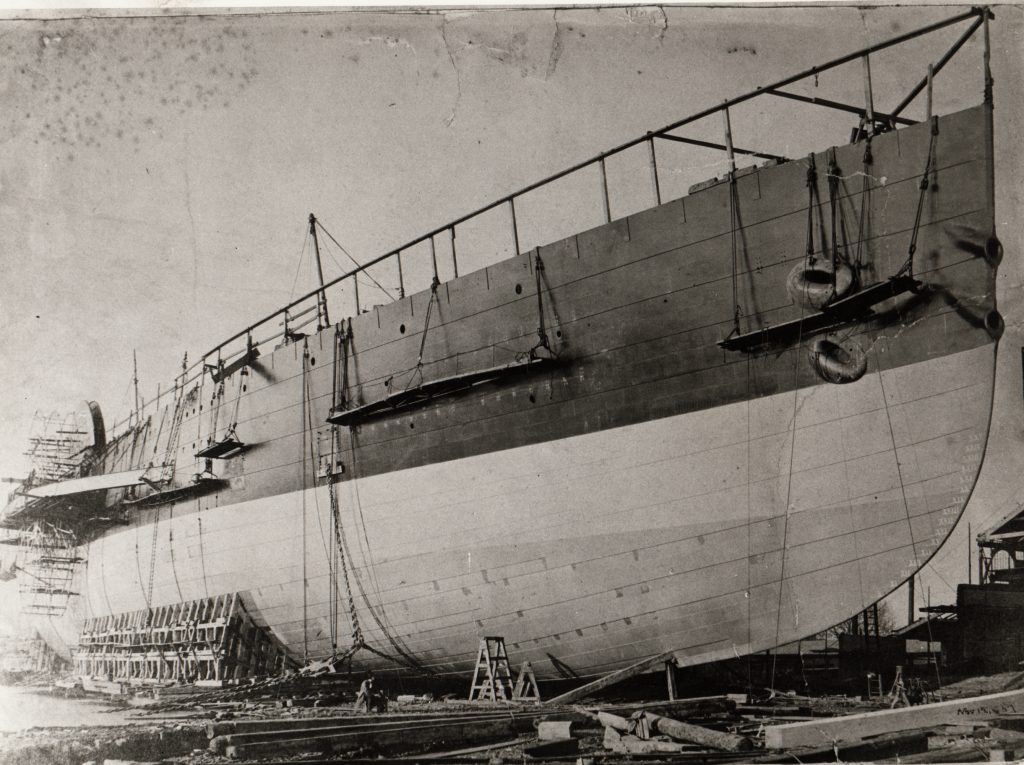The Great Eastern
The SS Great Eastern was the mid-nineteenth century’s Great Experiment – a passenger ship of a size never before seen; an iron ship surpassing anything that had come before.
And it failed.
If ever there had been a nautical equivalent of a white elephant, it was the Great Eastern. Conceived of by Isambard Kingdom Brunel and built by John Scott Russell of Millwall, London, in 1853 (and actually christened Leviathan), when the Great Eastern was put up for sale nine years later at half its material cost, there were no takers.

So, what happened to the Great Eastern?
Fate intervened. Mr Daniel Gooch, MP, a director of the Telegraph Construction & Maintenance Company (Telcon), saw an opportunity. There was a dream: intercontinental communication between Europe and North America via an electric telegraph submarine cable. To achieve this dream required a very large ship. There was only one very large ship. That very large ship had suddenly become available.
And what a ship it was
Nearly 19,000 gross registered tons, six masts, five funnels, four decks, side-mounted paddle-wheels, and a single propellor – the Great Eastern was 692 feet in length and would not be surpassed in length until the launch of the RMS Oceanic 40 years later. The hull was divided into ten watertight compartments. It could carry 4,000 passengers (800 first class, 2,000 second, 1,200 third) and achieve a speed of about 15 knots (or 27.7 kilometres per hour) if the paddle-wheels and propellor were used together.
The Great Eastern was put up for sale once more, and Gooch convinced Mr John Pender and Mr Thomas Brassey to invest in the purchase of the erstwhile passenger ship. They bought it for £25,000. They formed a company, the Great Eastern Steamship Company, and chartered the Great Eastern to Telcon.
The Great Eastern refitted as a cable-laying ship
Paying-out gear was installed, the fourth funnel was removed, and one of the deckhouses was converted into a testing-room for the electricians.
Three cable tanks were fitted into the ship’s large hull, with enough space for 2,489 nautical miles (or 4,609.6 kilometres) of telegraph cable. The distance between Ireland and Newfoundland was (and still is) just under 2,000 miles, or about 3,200 kilometres. These cable tanks were flooded so the cable could be kept immersed in water.
The Great Eastern made two attempts to lay the Transatlantic submarine cable, first in 1865 and then again in 1866. This second attempt succeeded, and very quickly Queen Victoria was congratulating US President Mr Andrew Johnson.

Perhaps this would have been the Great Eastern’s only claim to cable-laying fame, as the great ship’s next task was to carry American passengers to the Paris Exhibition, and so it was refitted as a passenger ship. The French author Jules Verne travelled on the Great Eastern at this time, writing about this ‘floating city’.
The call of telegraphy brought the Great Eastern back to the submarine cable business in 1869. There were more cables to be laid, including the Bombay to Aden cable, part of a project to link India to Great Britain, and the Calcutta to Singapore cable.
The Great Eastern retires from cable-laying and is used in a number of other industries
Another attempt to make the Great Eastern operate successfully as a passenger ship followed, but it ended in failure, and the Great Eastern found itself moored in Milford Haven for a year, and then another year, and another. It was used to drive pylons; it was used as a show-boat, a concert hall, and a gymnasium; and after 11 years, it was moved to Liverpool. There, it was used as a hoarding for a local department store.
It was a sad end. The Great Eastern was broken up on the River Mersey in 1889 and 1890.

It is said a ship launched in blood is an unlucky ship.
It was rumoured a riveter had been killed whilst building the ship. Over the course of its existence, the Great Eastern killed (directly or indirectly) some 30 people, suffered four mutinies of varying description, struck an uncharted rock close to Montauk Point, NY, and was the cause of 13 law-suits.
The Great Eastern has become the stuff of urban legend. There was a rumour that whilst the great ship was being scrapped, workmen found the skeleton of the lost riveter alongside another. There is no record of such a discovery and it is undoubtedly hearsay, but it illustrates the aura which surrounded the ship at the time.
But its practical legacy lies with modern communications.
As a passenger ship, it was the wrong ship at the wrong time. As a cable-ship, it was exactly what was needed: no other ship of its size existed at a time when the new-fangled technology of electric telegraph needed a very large ship, and the SS Great Eastern was a very large ship.
Author
Duncan S. Mackenzie, RITTech, AMBCS
Digital Collections Officer, PK Porthcurno
Header image: Framed painting by C. Lewis of the Atlantic Telegraph Expedition landing of the cable in Hearts Content on July 27, 1866. Image shows the Great Eastern in the bay surrounded by other ships, all the ships have flags flying, in the bottom left-hand corner has been painted a man sitting down sketching the scene which could be the artist.
